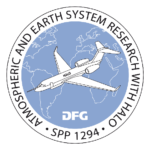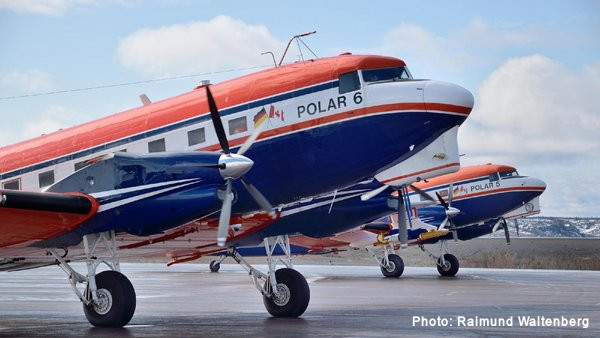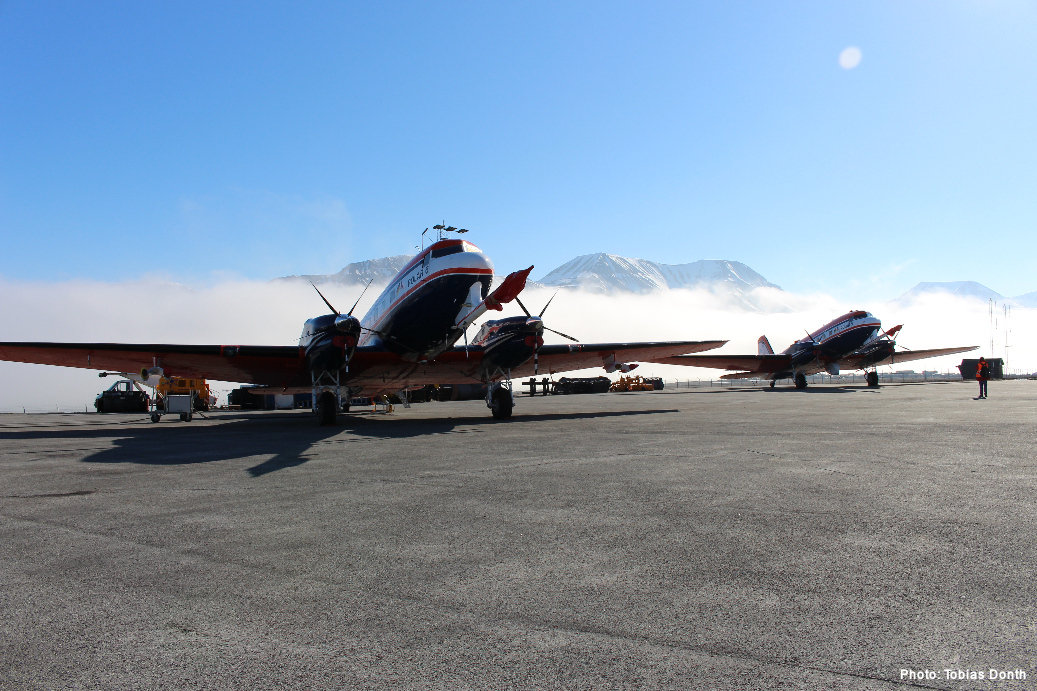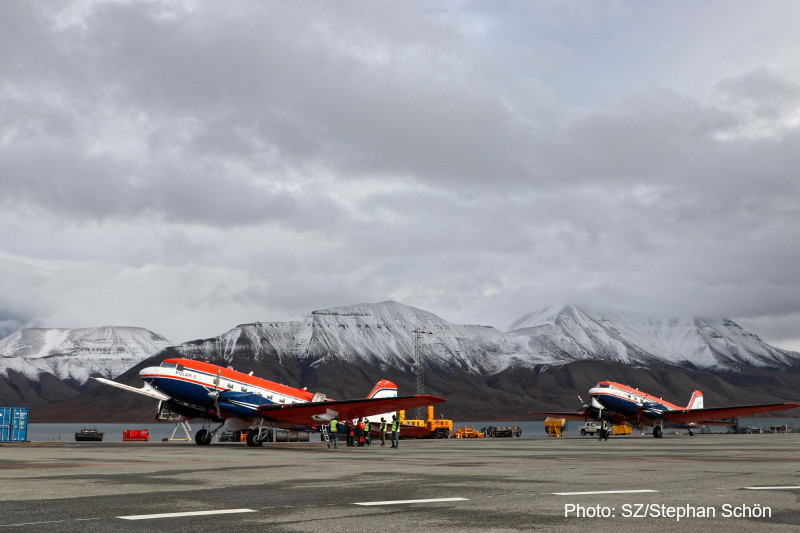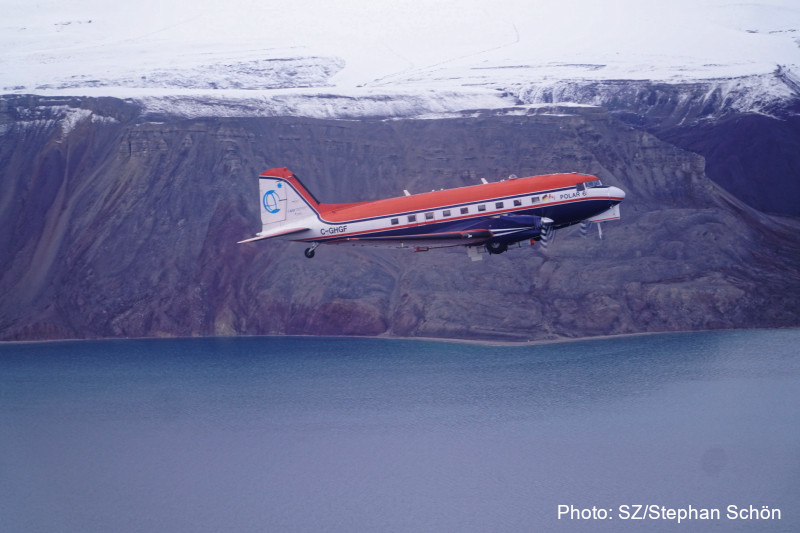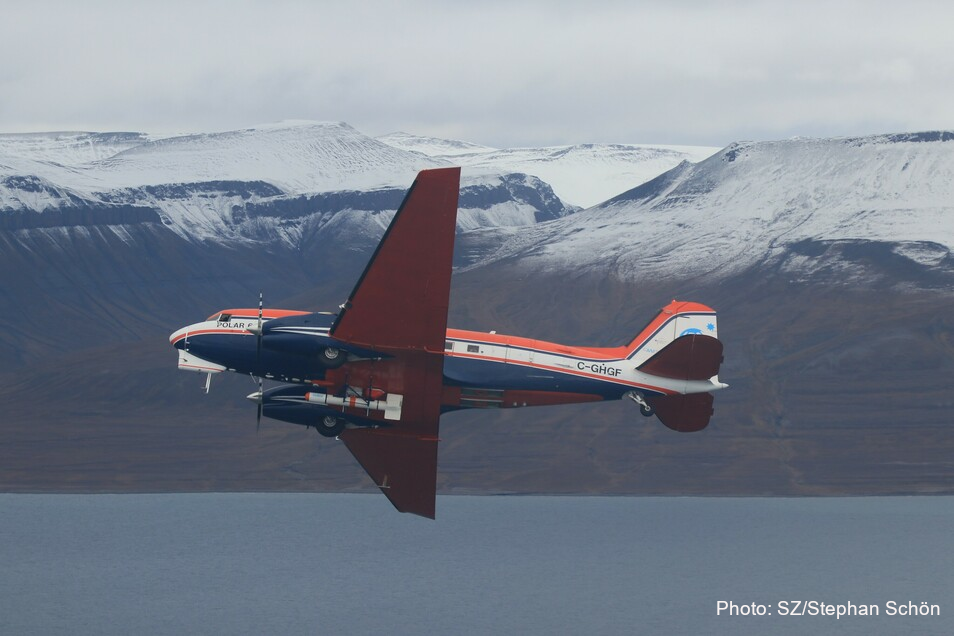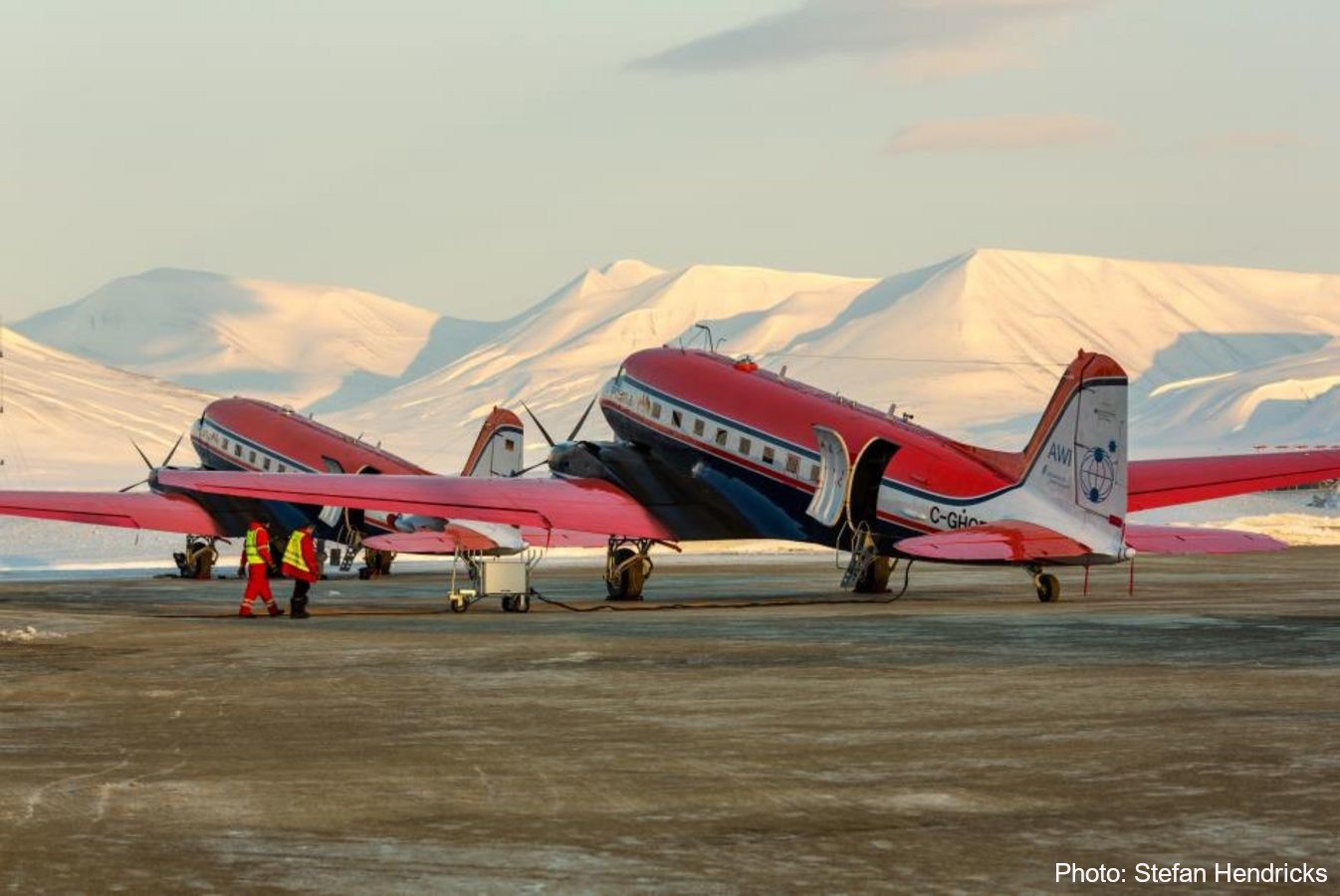Polar 5
| Instrument | Instrument Description | Operator |
|---|---|---|
| AMALi Lidar | The AMALi transmits Nd:YAG laser light pulses either upward (zenith configuration) or downward (nadir). The laser light interacts with and is changed by atmospheric constituents influencing the backscattered light intensity. The backscattered light is collected with an off-axis telescope mirror and directed onto the detection system. The detection of the two wavelengths 355 nm and 532 nm (the latter in both perpendicular and parallel polarisation mode) provides an information on existence, distribution, backscatter and depolarisation of aerosols and thin clouds in the troposphere. The applied 2-minute integration time results in a horizontal resolution range from 4.3 km to 12.4 km for a minimum of 130 km/h and a maximum of 370 km/h aircraft cruising speed over ground, respectively. The transient recorders register the backscattered light with a maximum sampling rate of 21 MHz corresponding to a range/height resolution of 7.5 m. The on-line quick look data evaluation allows an immediate interpretation. | AWI |
| MiRAC-A | The Microwave Radar/radiometer for Arctic Clouds (MiRAC-A) consists of a single vertically polarized Frequency Modulated Continous Wave (FMCW) cloud radar including a passive channel at 89 GHz. The cloud radar of MiRAC-A provides vertically resolved profiles of the equivalent radar reflectivity with a sensitivity of -50 dBZ at an altitude of 2 km with a 10 m vertical resolution and a transmitter power of 1.5 W. | IGM |
| AISA Hawk | The Airborne Imaging Spectrometer for Applications (AISA) Hawk instrument consists of a downward-viewing push broom sensor alignedacross the flight track to measure 2D fields of upward radiance. The push broom sensor contains 384 across-track pixels, where each pixel performs spectral measurementsbetween the wavelength range of 930 nm and 2550 nm in 288 channels. With a 36°fieldof view (FOV) and a sampling frequency of 20 Hz, the instrument has a spatial resolutionof 2 m, assuming a distance between aircraft and cloud of 1 km. | LIM |
| AISA Eagle | The AISA Eagle instrument is the second imaging spectrometer installed on Polar 5. Ituses a measurement approach similar to AISA Hawk but focuses on shorter wavelengthswith higher spectral and spatial resolution. With a single line push broom sensorconsisting of 1024 across-track pixels measurements of 2D fields of upward radiance areperformed in 488 channels covering a wavelength range between 400 nm and 970 nm.The FOV is 36.3°and delivers a spatial resolution below 1 m for a target at a distance of 1 km. During MOSAiC-ACA it was operated with a frame rate of 20 Hz to acquire an along-track spatial resolution comparable to that of AISA Hawk. | LIM |
| Smart Albedometer | The Spectral Modular Airborne Radiation measurement sysTem, SMART-Albedometer, measures upward and downward spectral irradiances and radiances in the spectral range from 0.3 to 2.2 μm. The radiation is collected by optical inlets which are different for the radiance and the irradiance. The collected radiation is transmitted with fibre optical cables to spectrometers of different types. Between 0.3 to 1.0 μm the spectrometers have a spectral resolution (FWHM) of 2-3 μm. Both upper und lower sensor package are actively horizontal stabalized, which is necessary to accurately measure irradiance. The SMART measurements will be used to measure cloud top and surface albedo to quantify the solar energy budget in the Arctic atmosphere. Especially the cloud solar radiative forcing in dependence of surface albedo will be investigated. Spectral radiance from SMART will be used for cloud remote sensing retrieving cloud optical properites such as cloud otpical thickness, partical effective diameter and the cloud thermodynamic phase. | LIM |
| 180° Fish-Eye Camera | A commercial Nikon DF camera is used in combination with a 180° fish-eye lense to measure the angular distribution of solar radiance in the lower hemisphere below the aircraft. The fish-eye camera is calibrated similar to SMART-Albedometer and provides images with high spatial resolution up to a frequency of 4 s. In combination with the SMART-Albedometer downward irradiance, the hemispherical-directional reflectivity distribution function (HDRF comparable to BRDF) can be derived. The measurements will be analyzed for sea ice surfaces as well as for clouds. The sea ice, snow HDRF will be characterized in dependence of sea ice fraction, snow cover and surface roughness. Measurements above clouds provide cloud thermodynamic phase and for liquid clouds, particle diameter by analyzing the backscatter directions with cloud bow and glory. | LIM |
| Sun- Photometer | The Sun-Photometer is installed under a quartz dome of Polar 5 to derive the spectral aerosol optical depth. Therefore, it uses a filter wheel with ten selected wavelengths. The optics of the Sun-Photometer use an aperture with a field of view of 1° to measure the direct solar irradiance. Knowing the extraterrestrial signal the spectral optical depth of the atmosphere and the spectral optical depth of aerosol can be derived. | AWI |
| AVAPS Lite Dropsonde System | AVAPS Lite dropsonde system using Vaisala RD-41 sondes to measure temperature with an accuracy of 0.1 °C, humidity with an accuracy of 2 %RH, pressure with an accuracy of 0.4 hPa. Winds are derived from GPS position measurements. | AWI |
| SUNHAT |
The microwave radiometer operated on Polar 5 is a Humidity And Temperature PROfiler (HATPRO). Usually, this instrument is looking upward when operated on ground. It has seven channels along the water vapor absorption line at 22.24 GHz and seven close to the oxygen absorption complex at around 60 GHz. The humidity channels can be used to retrieved humidity profiles, integrated water vapor, and liquid water path, wheres the ones in the oxygen complex can provide information on the temperature profile. In addition to measure atmospheric parameters, it can be used to derive the microwave emissivity of ocean and sea ice. | IGM |
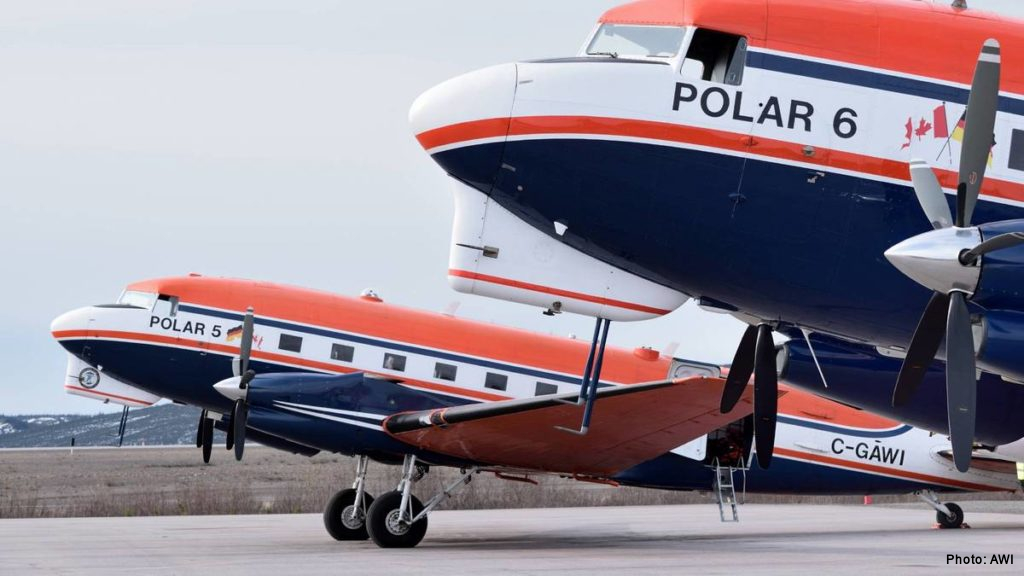
Polar 6
| Instrument | Instrument Description | Operator |
|---|---|---|
| Polar- Nephelometer | The Polar-Nephelometer is able to measure the phase function of ambient aerosol particles. | LaMP |
| PIP | The Precipitation Imaging Probe (PIP) measures particle sizes in a range from 100 µm to 6.2 mm using an optical array with 64 elements. | LaMP |
| CIP | The Cloud Imaging Probe (CIP) is an optical spectrometer and measures cloud particle sizes in a range from 25 µm to 1550 µm. In addition it measures the liquid water content in a range from 0.01 g/m3 to 3 g/m3. | DLR |
| 2D-S | The 2D-S is an optical imaging instrument and records two dimensional images of cloud particles with two 128 photodiode arrays. | |
| CCP | The cloud combination probe (CCP) combines a cloud imaging probe (CIP) and a cloud droplet probe (CDP) and covers a size range between 2 µm and 1000 µm. | DLR |
| Nevzorov Probe | The Nevzorov probe measures the total and liquid water content in a range from 0.003 to 3 g m−3. | AWI LaMP |
| CVI | The Counterflow Virtual Impactor (CVI) inlet is developed for the in-situ collection of cloud droplets and ice particles by simultaneous discrimination of non-activated particles. | TROPOS |
| CPC | The condensation particle counter (CPC) measures the cloud particle residual and ambient aerosol particle number concentration for diameters larger 10 nm. | TROPOS |
| UHSAS | The ultra-high sensitivity aerosol spectrometer (UHSAS) measures the cloud particle residual and ambient aerosol particle number size distribution in a diameter range between 60 and 1000 nm. | TROPOS |
| OPC | The optical particle counter (OPC) measures the cloud particle residual and ambient aerosol particle number size distribution in a diameter range between 0.25 and 10 µm. | MPIC |
| PSAP | The particle soot absorption photometer (PSAP) measures the absoption coefficient of cloud particle residual and ambient aerosol particles, which can be transferred into a BC mass concentration. | TROPOS |
| SP2 | The single-particle soot photometer (SP2) quantifies the concentration and size distribution of refractory black carbon. It is based on a laser-induced incandescence technique that allows for quantifying the mass of refractory BC particles. | AWI |
| ALABAMA | The Aircraft-based Laser Ablation Aerosol Mass spectrometer (ALABAMA) is a bipolar-ion single particle analysis instrument that samples aerosol particles and cloud particle residuals with diameters ranging from 200 nm up to 3 µm. The ALABAMA can identify size and bipolar mass spectra of these particles. | MPIC |
| Aerolaser AL5002 | The Aerolaser AL5002 measures the carbon monoxide (CO) mixing ratios based on vacuum ultraviolet- (VUV) fluorimetry by using the excitation of CO at 150nm. | IPA Mainz |
| Licor LI-7200 | The LI-7200 is a commercial high precision Non Dispersive Infrared (NDIR) CO2/H2O Analyzer from LI-COR Biosciences GmbH which was modified for aircraft operations. The mixing ratios of CO2 and H2O are determined via the infrared absorption ratios of both gases measured within the absorption sample cell. | IPA Mainz |
| 2BTech O3 monitor |
The 2B Technologies Dual Beam Ozone Monitor 205 is designed to enable accurate measurements of atmospheric ozone over a wide dynamic range extending from a limit of detection of 1 ppbv to an upper limit of 100 ppmv based on the well-established technique of absorption of ultraviolet light at 254 nm. | IPA Mainz |
| HERA | High Volume Aerosol Sampler (HERA), designed for aircraft operations. HERA collects aerosol particles on polycarbonate pore filters. A shrouded inlet diffuser is used to get the particles into the aircraft. | TROPOS |
| Nose Boom | Nose Boom is equipped with a five-hole probe to perform high frequency measurements of 3D wind vector, temperature and humidity, which are needed to calculate e.g. the turbulent kinetic energy flux. | AWI |

